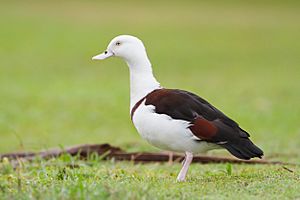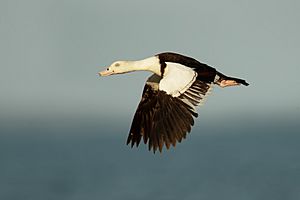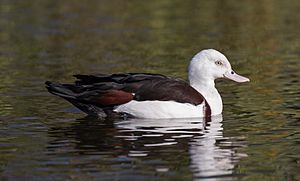Radjah shelduck facts for kids
The radjah shelduck (Radjah radjah) is a special type of shelduck. You can mostly find it in New Guinea and Australia. It also lives on some of the Moluccas. People sometimes call it the raja shelduck, black-backed shelduck, or the Burdekin duck in Australia.
Quick facts for kids Radjah shelduck |
|
|---|---|
 |
|
 |
|
| Conservation status | |
| Scientific classification | |
| Genus: |
Radjah
|
| Species: |
radjah
|
| Subspecies | |
|
R. r. radjah (Lesson, 1828) |
|
| Synonyms | |
|
Tadorna radjah |
|
Contents
What Makes the Radjah Shelduck Special?
Scientists used to think the radjah shelduck belonged to a group called Tadorna. But they noticed it looks very different from other birds in that group. They also studied its DNA.
This special DNA information showed it was unique. So, now it has its very own group, called Radjah. This means it's the only bird in that specific group.
What Does the Radjah Shelduck Look Like?
Both male and female radjah shelducks are mostly white. They have dark tips on their wings. They also have a clear "collar" of dark feathers around their necks.
When they fly, you can see green stripes on the top of their wings. The female makes a loud, rattling sound. The male makes a soft, breathy whistle, almost like a sore throat.
Where Do Radjah Shelducks Live?
The radjah shelduck lives in mangrove forests and along the coast. You can find them in New Guinea and Australia. They also live on some of the Moluccas in eastern Indonesia.
In Australia, they mostly live along the northern coast. This includes places like central Queensland and the Northern Territory. You can even find them in Kakadu National Park. They also live in the Kimberley area of Western Australia.
Protecting the Radjah Shelduck
The radjah shelduck is a protected bird in all parts of Australia. It is against the law to hurt them or bother them. There are punishments for anyone who does.
These birds like the salty water of mangrove swamps. They also like swamps with paperbark trees. But during the wet season, they will visit freshwater swamps. They also go to lagoons and billabongs further inland.
How Do Radjah Shelducks Behave?
Radjah shelducks form strong pairs that stay together for a long time. You usually see them in single pairs or small groups. During the wet season, the males can get very grumpy. They have even been seen attacking their mates.
What Do Radjah Shelducks Eat?
Their main food is mollusks, which are like snails or clams. They also eat insects. They enjoy parts of sedge plants and algae.
Radjah Shelduck Reproduction and Life Cycle
Pairs start looking for places to build their nests in January and February. They build their nests close to where they find food. They often use hollow tree branches for their nests. This means that losing their homes is a big problem for them.
The radjah shelduck does not use many materials for its nest. It only uses some soft feathers from its own body. The female usually lays eggs in May or June. This timing depends on how long the wet season lasts.
A female can lay between 6 and 12 eggs at one time. The eggs hatch after about 30 days.
See also
 In Spanish: Tarro rajá para niños
In Spanish: Tarro rajá para niños



